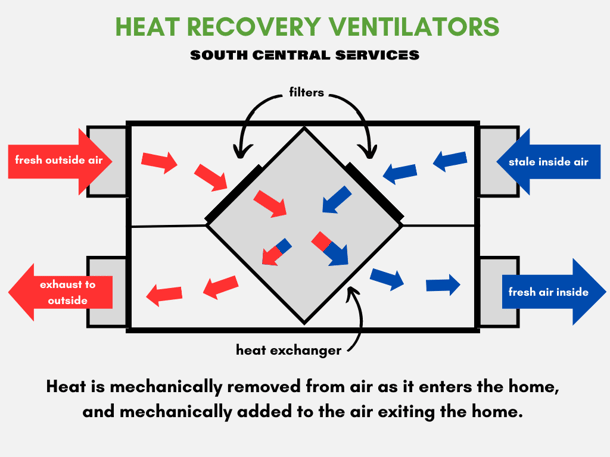How HRV Improves Indoor Air Quality and Comfort at Home
Checking out the Perks of Heat Recovery Ventilation for Power Performance in Residences
Heat Recovery Ventilation (HRV) systems supply homeowners a practical strategy to enhancing energy performance. By recovering warm from outward bound air, these systems can significantly decrease cooling and heating prices. Furthermore, they supply a constant supply of fresh air, enhancing indoor air top quality and convenience levels. As homeowners consider sustainable choices, understanding the subtleties of HRV systems comes to be significantly crucial. What variables should one examine prior to making such an investment?
Understanding Heat Recovery Ventilation Equipments

Just How HRV Enhances Indoor Air Quality

Energy Savings: The Monetary Benefits of HRV
Optimizing this hyperlink power effectiveness, heat recovery ventilation (HRV) systems supply considerable economic advantages for homeowners. By recuperating and reusing heat from exhaust air, HRVs markedly lower heating & cooling prices. This modern technology can bring about power savings of as much as 30%, relying on climate and use patterns. Property owners often observe reduced utility bills soon after installation, making HRVs a monetarily smart investment gradually. Additionally, lots of regions offer rewards or rebates for energy-efficient upgrades, even more enhancing the economic appeal. As energy costs proceed to climb, the cost-effectiveness of HRVs becomes significantly clear. Overall, the incorporation of HRV systems not only advertises power performance but likewise adds to long-lasting economic savings for households.
The Environmental Effect of Heat Recovery Ventilation
A considerable ecological advantage of heat recovery ventilation (HRV) systems depends find out this here on their capability to minimize overall energy consumption. By redeeming heat from exhaust air and moving it to inbound fresh air, HRV systems minimize the demand for energy-intensive home heating and cooling methods. This decrease in energy need adds to decrease greenhouse gas exhausts, as much less nonrenewable fuel source is called for to preserve comfy indoor temperatures. Furthermore, HRV systems improve interior air top quality by successfully trading stagnant air with fresh outside air, reducing dependence on mechanical cooling systems that can harm the environment. Generally, the application of HRV systems sustains lasting living techniques and aligns with global efforts to deal with environment change by advertising energy performance in property setups.
Picking the Right HRV System for Your Home
Just how can home owners ensure they pick the ideal heat recovery ventilation (HRV) system for their demands? First, they should assess their home's dimension and layout, as these elements affect air movement demands. Next off, examining the system's effectiveness rankings is vital, as higher rankings suggest far better efficiency and energy financial savings. Property owners need to also consider installment and upkeep expenses, contrasting different brands and versions for value. Additionally, it is necessary to assess sound degrees, as some systems run more quietly than others. Consulting with HVAC experts can offer customized recommendations based on details home problems. Checking out customer evaluations and service warranties can help in making an informed decision, making sure that the chosen HRV system efficiently improves indoor air high quality and energy efficiency.
Regularly Asked Inquiries

How Commonly Should I Tidy or Preserve My HRV System?
The regularity of cleansing or preserving a warm recuperation ventilation (HRV) system normally depends upon use and environmental elements. Generally, it is suggested to carry out maintenance every six months to ensure peak performance and air high quality.

Can HRV Equipments Help Minimize Moisture Levels Inside?
HRV systems can effectively minimize interior humidity degrees by exchanging stale, damp air with fresh, drier air from outdoors. HRV Heat Recovery Ventilation. This process aids keep a well balanced indoor setting, enhancing convenience and like it protecting against moisture-related concerns
What Is the Life-span of a Typical HRV System?
The life expectancy of a typical heat recovery ventilation (HRV) system differs, generally lasting between 10 to 15 years. Normal upkeep can expand its effectiveness and functional life, ensuring peak performance throughout its usage period.
Are There Any Sound Interest In HRV Solutions?
Sound worry about HRV systems can emerge, especially from fan operation. Many modern systems are made to reduce audio levels, guaranteeing they operate silently while maintaining efficiency, which attends to possible disruptions in living atmospheres.
Can I Mount an HRV System Myself, or Do I Need a Professional?
The individual contemplated whether to set up the heat recovery ventilation (HRV) system directly or work with an expert. Generally, while do it yourself installation is possible, knowledge guarantees correct performance and conformity with neighborhood structure codes, improving system effectiveness.